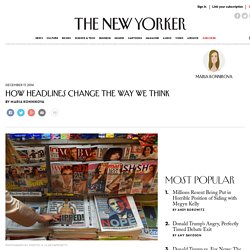

How Headlines Change the Way We Think. “Why Headlines Matter.”

“Misleading Headlines Can Lead You Astray.” “How What You Read Affects What You See.” “How Bad Headlines Make Bad Memories.” “Eleven Reasons Headlines Are Important.” “You’ll Never Believe How Important an Accurate Headline Is.” Those are all possible titles for this piece that I discussed with my editor. Psychologists have long known that first impressions really do matter—what we see, hear, feel, or experience in our first encounter with something colors how we process the rest of it. As a result of these shifts in perception, problems arise when a headline is ever so slightly misleading. It’s these sorts of misleading maneuvers that Ullrich Ecker, a psychologist and cognitive neuroscientist at the University of Western Australia, was pondering when he decided to test how slight—and slightly misleading—shifts in headlines can affect reading.
Ecker’s goal was to test whether the degree of the slant would matter. Your School Shapes How You Think About Inequality : NPR Ed. Ask yourself this question: Were you aware of inequality growing up?

Your answer may depend in part on where you went to high school. Students at racially diverse schools, particularly black and Hispanic students, are more tuned in to injustice than students going to school mostly with kids that look like them. That's one of the main threads of a new book by Carla Shedd, an assistant professor of sociology and African-American studies at Columbia University.
In Unequal City: Race, Schools, and Perceptions of Injustice, Shedd goes straight to the source: the students at four Chicago public high schools. She even let the kids pick their own pseudonyms. Two of the schools were largely segregated: one had no white or Asian students. Shedd followed the schools from 2001 to 2011, a turbulent decade when the city demolished its infamous high-rise public housing units and began closing public schools in large numbers.
Let's jump right in. So what does that look like from the student perspective? Lateral thinking riddles. 3 classic laws of thought. 20 cognitive biases. The 30 Most Common Ways You Can Lose an Argument. Top 10 Thinking Traps Exposed — How to Foolproof Your Mind, Part I. Our minds set up many traps for us. Unless we’re aware of them, these traps can seriously hinder our ability to think rationally, leading us to bad reasoning and making stupid decisions. Features of our minds that are meant to help us may, eventually, get us into trouble. Here are the first 5 of the most harmful of these traps and how to avoid each one of them. 1. The Anchoring Trap: Over-Relying on First Thoughts “Is the population of Turkey greater than 35 million? Lesson: Your starting point can heavily bias your thinking: initial impressions, ideas, estimates or data “anchor” subsequent thoughts.
This trap is particularly dangerous as it’s deliberately used in many occasions, such as by experienced salesmen, who will show you a higher-priced item first, “anchoring” that price in your mind, for example. What can you do about it? Always view a problem from different perspectives. 2. Consider the status quo as just another alternative. Inductive Reasoning - How Small Observations Infers a Theory. Inductive reasoning is the process where a small observation is used to infer a larger theory, without necessarily proving it.

Most scientists use this method to generate theories about how the universe works and discover the laws governing our very existence. Many ancient philosophers used induction for making observations and constructing theories. For example, the Ancient Greek philosophers believed that theories could be proved by logic alone and did not need experiments. They thought that mathematically strict laws, deduced from smaller observations, governed the universe.
Science has moved on over the millennia and now we realize the necessity of research by deductive reasoning. Theories have to be tested and hypotheses answered before the scientific community accepts them as truth. Deductive and inductive reasoning. Fallacy Examples Part 1. LA Logical Fallacies. The Mouse Who Ate the Cheese. Truth and validity. The 12 cognitive biases that prevent you from being rational. An Illustrated Book of Bad Arguments. A reader recently wrote in asking if I could share a bit about the process of putting the book together and talk about how the project started.

Certainly. I go on two solitary walks every day. There is a small park off the Embarcadero that is tucked away in a quiet spot. It has a pleasant stream flowing through it and an unassuming bench beside that stream. I have made walking to that frail bench a ritual, and the half an hour or so spent daydreaming on it amid the cool San Francisco breeze, an article of faith. It was on a day in October of last year when, during one of those quiet moments on that bench, I recalled my college years and how outspoken I happened to be during them, an observation only made interesting by the fact that I have since turned into the quietest of beings.
A realization that coincided with that nostalgic whiff was that a sizable amount of the discourse nowadays continues to be plagued with bad reasoning. Philosophy and the Matrix - Return to the Source (Full Documentary)